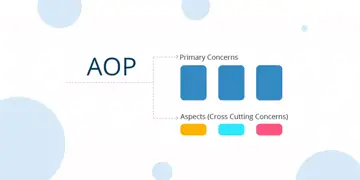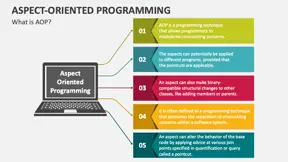What is AOP (Aspect-Oriented Programming)?
It can be difficult to manage complicated systems and codebases in the field of software development. You'll probably run into problems with code modularity, maintainability, and a clear separation of concerns as your program expands. Aspect-Oriented Programming (AOP) can be used in this situation. With a particular focus on how AOP functions within the context of the Spring Framework, Aniday will examine What is AOP, look into some of the popular AOP frameworks, and become familiar with the common terminologies connected with AOP in this blog.

AOP (Aspect-Oriented Programming)
What is AOP?
AOP, or aspect-oriented programming, is a programming paradigm that addresses one of the most prevalent problems in software development: handling cross-cutting concerns. What are, however, cross-cutting issues, and how does AOP deal with them?
Cross-cutting concerns are aspects of a program that affect multiple parts of the codebase, often cutting across the traditional boundaries of classes and modules. Tasks like logging, security, error handling, performance monitoring, and transaction management are among these issues. Such issues entangle with the central business logic in a conventional object-oriented programming (OOP) model, creating difficult-to-read, difficult-to-maintain code that is also difficult to test.
AOP offers a new way to address these concerns by introducing the concept of "aspects." An aspect is a module or component that encapsulates a cross-cutting concern, essentially separating it from the main codebase. Aspects contain logic related to a specific concern and can be applied to different parts of the application without altering the core functionality.
Key Concepts in AOP

AOP relies on several key concepts that help developers manage cross-cutting concerns effectively:
-
Aspect: An aspect is a module or component that encapsulates a cross-cutting concern. It defines the behavior to be applied at specific points in the program's execution. Aspects are independent entities, allowing for better organization and separation of concerns.
-
Join Point: A join point is a specific point in the program's execution where the behavior defined in an aspect can be applied. These points can include method calls, object instantiations, and more.
-
Advice: Advice is the code within an aspect that specifies what should happen at a particular join point. There are several types of advice, including "before," "after," "around," and "after-throwing." These determine when the aspect's code should execute concerning the join point.
-
Pointcut: A pointcut is an expression that selects a set of join points where advice should be applied. It defines the criteria for identifying the join points where the aspect's behavior will be executed.
-
Weaving: Weaving is the process of integrating the aspects into the application code. This can happen at different stages, such as compile-time, load-time, or runtime weaving, depending on the chosen AOP framework and language.
Dominant Frameworks in AOP
Several AOP frameworks are available for various programming languages, providing tools and libraries to implement AOP principles effectively. Let's explore some of the dominant AOP frameworks:
1. AspectJ
AspectJ is one of the most well-known AOP frameworks for Java. It extends the Java language with AOP capabilities, allowing developers to define aspects, pointcuts, and advice directly in their Java code. AspectJ provides various weaving options, including compile-time and load-time weaving.
2. Spring AOP
Spring AOP is a part of the Spring Framework, which is widely used in Java development. It provides a more lightweight approach to AOP, using proxy-based mechanisms to apply aspects to Spring-managed beans. Spring AOP is often favored for its simplicity and integration with the Spring ecosystem.
3. PostSharp
An AOP framework for.NET languages like C# and VB.NET is called PostSharp. It provides a method for defining aspects utilizing unique properties and smoothly integrates with the.NET development process. In the.NET environment, PostSharp is renowned for its user-friendliness and capacity to address interdisciplinary issues.
4. Guice AOP
Guice AOP is an AOP framework provided by the Google Guice dependency injection framework. It allows developers to define aspects using annotations and integrates well with Guice-managed components.
These frameworks differ in their approaches, but they all aim to simplify the implementation of AOP principles and make it easier for developers to manage cross-cutting concerns.
How Aspect-Oriented Programming works with Spring

The Spring Framework is a popular choice for Java developers, known for its robustness and versatility. Spring AOP, a part of the Spring Framework, leverages AOP principles to address cross-cutting concerns in a clean and efficient manner. Let's take a closer look at how AOP works with Spring:
1. Spring AOP
Spring AOP provides a lightweight and non-intrusive way to implement AOP in Spring applications. It uses proxy-based mechanisms to apply aspects to Spring-managed beans. Here's how it works:
2. AspectJ Integration
Spring AOP integrates seamlessly with AspectJ, allowing you to define aspects and pointcuts using AspectJ's syntax. This means you can leverage the full power of AspectJ while benefiting from Spring's core features.
3. Declarative Configuration
Spring AOP supports declarative configuration of aspects and advice using XML or Java annotations. This makes it straightforward to define and apply aspects to your Spring beans.
4. Proxy-Based AOP
Spring AOP relies on proxy objects to implement aspects. When you request a bean from the Spring container, you receive a proxy object instead of the actual bean. This proxy object intercepts method calls, allowing the associated aspect to execute before or after the actual method.
5. Supported Advice Types
Spring AOP supports various advice types, including "before" advice (executed before the method), "after" advice (executed after the method), and "around" advice (which can fully control the method's invocation). This flexibility enables you to address a wide range of cross-cutting concerns.
6. Dynamic Weaving
Spring AOP primarily uses runtime weaving, which means aspects are woven into the application code dynamically when the application runs. This makes it suitable for applications where you want to change aspects without recompiling the entire codebase.
7. Integration with IoC
Spring AOP integrates seamlessly with Spring's Inversion of Control (IoC) container. It allows you to manage your beans and aspects in a single, unified context, making it easier to configure and maintain your application.
Common Terminologies in AOP
To dive deeper into AOP, it's essential to understand some common terminologies used in the AOP context:
-
Aspect: As mentioned earlier, an aspect is a module or component that encapsulates a cross-cutting concern.
-
Join Point: A join point is a specific point in the program's execution, where the aspect's behavior can be applied. This could be a method call, an object creation, or other program events.
-
Advice: Advice is the code within an aspect that specifies what should happen at a particular join point. Different types of advice include "before" (executed before the join point), "after" (executed after the join point), "around" (wraps the join point), and "after-throwing" (executed when an exception is thrown at the join point).
-
Pointcut: A pointcut is an expression that defines the criteria for selecting join points where advice should be applied. It allows you to specify when and where the aspect's behavior should be triggered.
-
Weaving: Weaving is the process of integrating the aspects into the application code. It can occur at different stages: compile-time, load-time, or runtime weaving, depending on the chosen AOP framework and language.
Conclusion
Aspect-Oriented Programming (AOP) is a powerful paradigm that offers a solution to the challenges of managing cross-cutting concerns in complex software systems. By introducing aspects, join points, advice, pointcuts, and weaving, AOP provides a structured and modular approach to handling concerns such as logging, security, and error handling. Understanding the common terminologies associated with AOP is crucial for developers looking to enhance code modularity, maintainability, and the clean separation of concerns in their applications.
In the context of the Spring Framework, Spring AOP provides a non-intrusive way to leverage AOP principles. It seamlessly integrates with Spring's core features and enables the clean and efficient management of cross-cutting concerns. With AOP, Spring developers can create maintainable and robust software systems even in the face of increasing complexity. Aniday hopes that this article provide you vulnerable information of "What is AOP".
Aniday's HR Services
Headhunting Service
Find and recruit quality candidates in just 1 week! Supported by 40,000 experienced headhunters in IT, Finance, Marketing… capable of recruiting in any region.
Headhunting Service ➔Employer of Record (EOR) Service
On behalf of your business, we recruit employees and handle payroll without the need to establish a company in markets such as Vietnam, Singapore, Malaysia, India, Indonesia…
Employer of Record (EOR) Service ➔